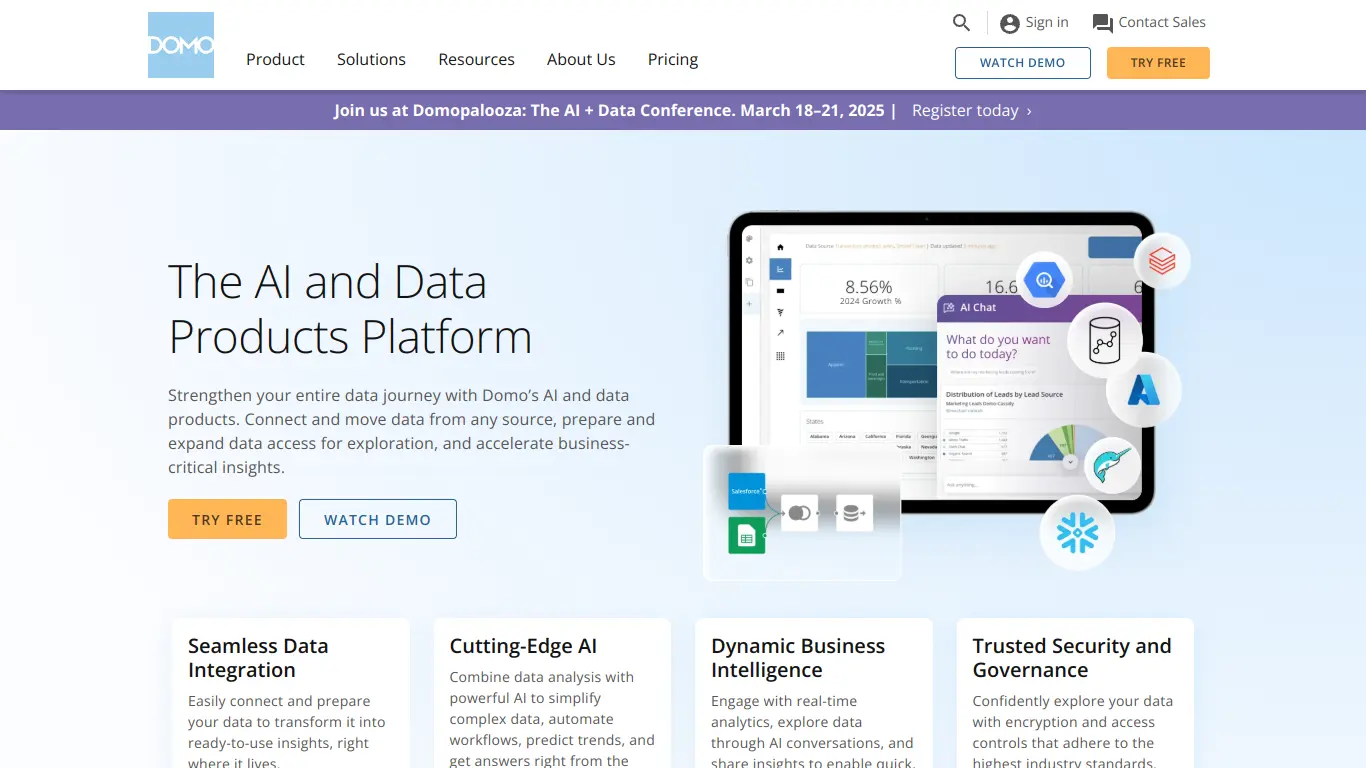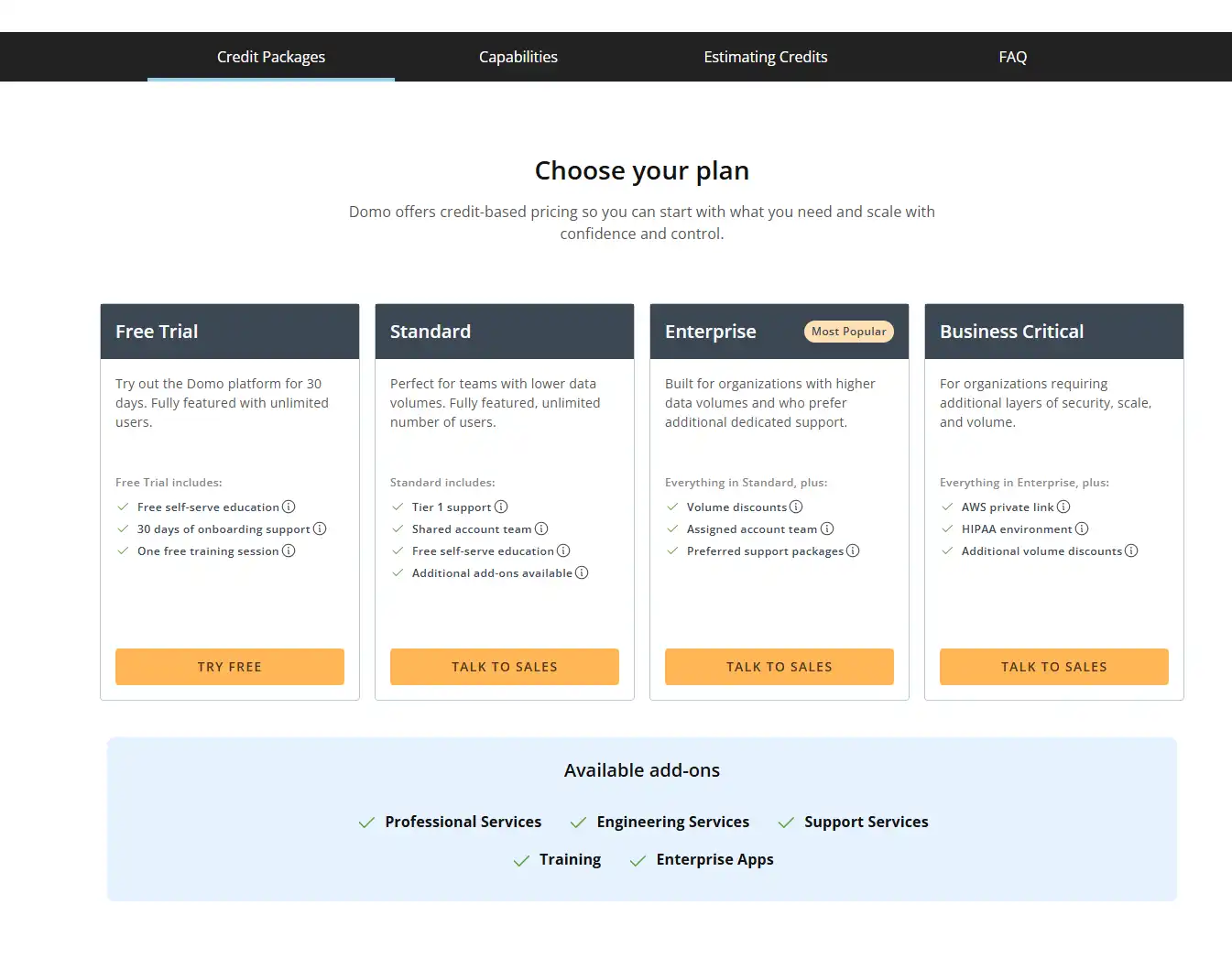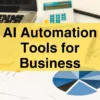Domo is an all-in-one BI platform that connects data sources, visualizes insights, and enables real-time collaboration for data-driven decisions.

Introduction to Domo
What is Domo and its Purpose?
Domo is an advanced cloud-based business intelligence (BI) platform that integrates data from multiple sources to provide real-time insights through interactive dashboards and visualizations. Unlike traditional BI tools that often require technical expertise, Domo emphasizes accessibility and user-friendliness, allowing both technical and non-technical users to connect, combine, visualize, and act on data.
The platform’s primary purpose is to solve the “last mile” problem in business intelligence—connecting insights directly to action. Domo accomplishes this by delivering real-time data in a digestible format to everyone across an organization, from C-suite executives to frontline employees, enabling data-driven decision making at all levels.
As the company itself states, “Domo puts data to work for everyone.” This mission encompasses their approach to democratizing data access while maintaining enterprise-grade security and governance.
Who is Domo Designed For?
Domo serves a diverse range of users across organizations:
- Business Executives: CEOs, CFOs, and other leaders who need high-level insights and KPIs to guide strategic decisions
- Data Analysts and Data Scientists: Technical users who can leverage Domo’s advanced analytics capabilities
- Department Managers: Mid-level decision makers who need to monitor team performance and operational metrics
- IT Professionals: Teams responsible for data integration and system management
- Marketing Teams: Professionals tracking campaign performance, customer engagement, and ROI
- Sales Teams: Representatives monitoring pipeline, forecasts, and customer metrics
- Operations Teams: Staff optimizing processes and supply chains
Domo is particularly valuable for organizations dealing with data silos—where information exists in multiple disconnected systems—as it excels at unifying data for comprehensive analysis. The platform scales from SMBs to enterprise-level organizations across industries including retail, financial services, healthcare, manufacturing, and technology.
Getting Started with Domo: How to Use It
Starting with Domo involves a straightforward process:
- Sign Up: Visit Domo.com and request a demo or free trial to evaluate the platform.
- Connect Data Sources: Use Domo’s 1,000+ pre-built connectors to integrate data from sources like Salesforce, Google Analytics, social media platforms, databases, spreadsheets, and more.
- Transform Data: Clean, combine, and prepare your data using Domo’s ETL (Extract, Transform, Load) tools without writing complex code.
- Build Visualizations: Create cards (Domo’s term for visualizations) using drag-and-drop interfaces to display your data through charts, graphs, tables, and other visual formats.
- Organize Dashboards: Arrange related cards into dashboards that tell a cohesive story about your business data.
- Share Insights: Invite team members to view dashboards, collaborate on analysis, and set up automated alerts for important metrics.
- Take Action: Leverage insights to make data-driven decisions and monitor the impact of those decisions in real-time.
For new users, Domo offers comprehensive documentation, tutorials, and a robust support community through the Domo University and Knowledge Base, making the learning curve manageable even for those with limited technical expertise.
Domo’s Key Features and Benefits
Core Functionalities of Domo
Domo’s platform encompasses several powerful capabilities:
1. Data Integration
- 1,000+ pre-built connectors for nearly any business application
- Federated access to data without moving it from source systems
- Real-time data synchronization capabilities
- Custom API integration tools
2. Data Transformation
- Magic ETL: A visual, no-code data transformation tool
- Workbench: Desktop application for local data preparation
- DataFlows: Visual workflow builder for complex data manipulations
- SQL DataFlows: SQL-based transformation for technical users
3. Data Visualization
- 150+ chart types and visualization options
- Beast Mode calculations for on-the-fly data manipulation
- Analyzer for visual data exploration
- Custom app development capabilities
4. Collaboration Tools
- Buzz: Built-in collaboration and messaging system
- Projects: Task management within the platform
- Annotations and commenting on visualizations
- Automated alerts and notifications
5. AI and Advanced Analytics
- Domo Everywhere: Embedded analytics for external sharing
- AutoML capabilities for predictive modeling
- Natural Language Processing for conversational queries
- Jupyter notebook integration for data scientists
6. Mobile Experience
- Native iOS and Android applications
- Offline access to critical dashboards
- Touch-optimized interface for on-the-go insights
Advantages of Using Domo
Domo delivers significant benefits that set it apart:
🚀 Speed to Insight
The platform dramatically reduces the time from data collection to actionable insight. What might take months with traditional BI tools can often be accomplished in days or even hours with Domo.
🔄 Real-time Updates
Unlike static reports that quickly become outdated, Domo provides constantly refreshed data, ensuring decisions are based on current information.
🤝 Democratized Data Access
By making complex data approachable for non-technical users, Domo breaks down information silos and creates a data-driven culture throughout organizations.
🔍 Single Source of Truth
By unifying disparate data sources, Domo eliminates conflicting information and establishes consistent metrics across departments.
📱 Mobility
Robust mobile apps ensure decision-makers have access to critical insights anywhere, anytime.
🛡️ Enterprise-grade Security
Despite making data widely accessible, Domo maintains rigorous security with role-based access controls, data encryption, and comprehensive governance features.
⚡ Scalability
The platform can handle billions of rows of data while maintaining performance, growing alongside organizations’ analytical needs.
Main Use Cases and Applications
Domo serves diverse business needs across departments:
Executive Dashboards
- Company-wide KPI monitoring
- Financial performance tracking
- Strategic decision support
Sales Analytics
- Pipeline visibility and forecasting
- Sales representative performance
- Territory and account analysis
Marketing Intelligence
- Campaign performance measurement
- Multi-channel attribution modeling
- Customer journey mapping
- Social media analytics
Financial Analysis
- Expense management
- Budget vs. actual tracking
- Financial forecasting
- Audit and compliance reporting
Supply Chain Optimization
- Inventory management
- Supplier performance tracking
- Logistics optimization
- Demand forecasting
Human Resources
- Workforce analytics
- Recruitment funnel tracking
- Employee performance metrics
- Diversity and inclusion monitoring
Customer Experience
- Customer satisfaction tracking
- Support ticket analysis
- Churn prediction
- Customer lifetime value analysis
IoT and Operational Technology
- Machine performance monitoring
- Predictive maintenance
- Production efficiency tracking
- Quality control metrics
Exploring Domo’s Platform and Interface
User Interface and User Experience
Domo’s interface strikes a balance between powerful functionality and user-friendly design:
Card-based Visualization System
The fundamental unit of Domo’s interface is the “card”—a versatile visualization that can display anything from simple metrics to complex charts. Cards can be customized, resized, and arranged to create intuitive dashboards.
Intuitive Navigation
The platform features a clean, consistent navigation structure with:
- A central dashboard view showing key metrics
- Left-side navigation menu for accessing different sections
- Search functionality for quickly finding specific data or content
- Consistent design patterns throughout the platform
Customization Options
Users can personalize their experience with:
- Custom dashboard layouts
- Tailored color schemes and branding
- Personalized alerts and notifications
- Saved filters and favorite views
Interactive Analysis
The interface supports dynamic data exploration:
- Drill-down capabilities to explore underlying data
- Filter controls to segment information
- Date range selectors for temporal analysis
- Hover and click interactions for additional context
Collaboration Features
Domo integrates communication directly into the analytics experience:
- Comment threads attached to specific visualizations
- @mentions to engage colleagues
- Annotation tools to highlight insights
- Sharing controls for distributing dashboards
The overall UX philosophy emphasizes making complex data accessible through intuitive design, guided workflows, and contextual help.
Platform Accessibility
Domo prioritizes making data accessible across devices and to users of all technical abilities:
Cross-device Compatibility
- Responsive web interface that adapts to screen sizes
- Native mobile applications for iOS and Android
- Optimized tablet experience
- Apple Watch integration for key alerts
Accessibility Compliance
- Support for screen readers
- Keyboard navigation options
- Color contrast considerations
- Text scaling compatibility
Language Support
- Multi-language interface options
- International date and number formatting
- Unicode support for global character sets
Learning Resources
- Interactive tutorials and guided tours
- Contextual help throughout the platform
- Domo University for structured learning
- Extensive documentation and knowledge base
Performance Optimization
- Fast loading times even for complex dashboards
- Efficient data handling for large datasets
- Progressive loading of content for quick initial interaction
- Offline capabilities for critical metrics
Domo Pricing and Plans
Subscription Options
Domo offers a tiered pricing structure designed to accommodate organizations of different sizes and needs:

Custom Solutions
For organizations with unique requirements, Domo offers tailored packages with custom pricing based on specific needs, data volume, and integration complexity.
While Domo doesn’t publish exact pricing on their website, industry analysis suggests plans typically start around $50-$75 per user per month for the Standard tier, with Enterprise plans ranging from $125-$175 per user monthly. For precise pricing, potential customers must contact Domo’s sales team for a custom quote based on their specific requirements.
Free vs. Paid Features
Free Options:
- Domo offers a free trial period (typically 30 days) allowing prospective customers to test the platform
- Limited free access through Domo’s shared app marketplace for specific use cases
- Free educational resources through Domo University
Paid-Only Features:
- Enterprise-grade security and governance
- Advanced ETL capabilities
- Custom app development
- Unlimited data storage
- API access
- Embedded analytics (Domo Everywhere)
- White-labeling options
- Advanced machine learning and AI features
- Priority support and consulting services
The most significant differentiators between free and paid tiers include data volume limitations, refresh frequency, user count restrictions, and advanced analytics capabilities that are only available in paid plans.
Domo Reviews and User Feedback
Pros and Cons of Domo
Based on aggregated user reviews from G2, Capterra, TrustRadius, and other review platforms:
Pros:
- Intuitive Interface: Users consistently praise Domo’s user-friendly design, making it accessible to non-technical users.
- Comprehensive Data Integration: The vast array of pre-built connectors simplifies bringing together data from diverse sources.
- Visualization Flexibility: The platform offers extensive options for creating compelling visual representations of data.
- Mobile Experience: The native mobile apps receive high marks for functionality and design.
- Quick Time to Value: Many users report faster implementation compared to traditional BI platforms.
- Collaboration Features: The built-in collaboration tools enhance team communication around data.
Cons:
- Pricing Structure: Some reviewers mention that Domo can be expensive, particularly for smaller organizations.
- Learning Curve for Advanced Features: While basic functions are intuitive, mastering advanced capabilities requires significant time investment.
- Limited Customization in Lower Tiers: Some advanced customization options are only available in higher-priced plans.
- ETL Complexity: Complex data transformations sometimes require workarounds or technical expertise.
- Documentation Gaps: Users occasionally report challenges finding comprehensive documentation for specific advanced features.
- Performance with Very Large Datasets: Some users report performance issues when working with extremely large data volumes.
User Testimonials and Opinions
From Marketing Leaders:
“Domo transformed how we measure campaign performance. We went from weekly static reports to real-time dashboards that everyone on the team can access. Our decision-making speed improved dramatically.” – Marketing Director, Retail Industry
From IT Professionals:
“Implementation was smoother than expected. The connector library meant we didn’t have to build custom integrations for most of our systems. The governance features also gave us confidence in maintaining data security while democratizing access.” – CIO, Financial Services
From Data Analysts:
“Beast Mode calculations and Magic ETL have simplified what used to be complex data manipulation tasks. That said, there’s still a learning curve to master the more advanced features.” – Senior Data Analyst, Healthcare
From Executives:
“Having all our KPIs in one place with real-time updates has been game-changing for our executive team. We’re no longer making decisions based on last month’s data.” – CEO, Manufacturing Company
Critical Feedback:
“While Domo delivers on its promises, the cost scales quickly as you add users and advanced features. Make sure you have a clear ROI calculation before committing.” – CFO, Technology Company
Domo Company and Background Information
About the Company Behind Domo
Domo was founded in 2010 by Josh James, who previously founded and led Omniture (later acquired by Adobe for $1.8 billion). The company is headquartered in American Fork, Utah, and has grown to become a significant player in the business intelligence market.
Company Timeline:
- 2010: Founded by Josh James
- 2011: Raised $43 million in Series A funding
- 2013: Launched the first version of the Domo platform
- 2015: Reached unicorn status with a valuation over $1 billion
- 2018: Completed IPO on the NASDAQ under the symbol “DOMO”
- 2020: Expanded platform with advanced AI capabilities
- 2022: Continued growth with enhanced enterprise features
Leadership Team:
- Josh James: Founder and CEO
- David Jolley: Chief Financial Officer
- Catherine Wong: Chief Product Officer
- John Mellor: Chief Strategy Officer
Company Culture:
Domo emphasizes innovation, customer success, and a collaborative work environment. The company has been recognized for its workplace culture, receiving awards like Utah Business Magazine’s “Best Companies to Work For.”
Corporate Social Responsibility:
Through its “Domo for Good” initiative, the company provides technology and expertise to non-profit organizations, helping them leverage data for greater social impact.
Domo Alternatives and Competitors
Top Domo Alternatives in the Market
Several platforms compete with Domo in the business intelligence and data visualization space:
1. Tableau
A popular visualization-focused platform known for its powerful graphics and large user community.
2. Microsoft Power BI
Microsoft’s BI solution, offering tight integration with other Microsoft products and competitive pricing.
3. Looker (Google Cloud)
A modern BI platform emphasizing data modeling and embedded analytics capabilities.
4. Qlik Sense
Known for its associative engine and self-service analytics approach.
5. Sisense
Specializes in handling complex data with in-chip technology and embedded analytics.
6. ThoughtSpot
Features a search-based interface and AI-driven analytics.
7. MicroStrategy
Enterprise-focused with strong security and governance features.
8. Salesforce Einstein Analytics (Tableau CRM)
Offers deep Salesforce integration and AI-powered insights.
Domo vs. Competitors: A Comparative Analysis
| Feature | Domo | Tableau | Power BI | Looker |
|---|---|---|---|---|
| Pricing Model | Subscription-based | Subscription-based | Subscription-based with free tier | Subscription-based |
| Deployment | Cloud-first | Cloud, on-premises, hybrid | Cloud, on-premises, hybrid | Cloud-first |
| Data Integration | 1,000+ connectors | 200+ connectors | 100+ connectors | Depends on data modeling |
| Mobile Experience | Native iOS/Android apps | Native iOS/Android apps | Native iOS/Android apps | Mobile responsive web |
| Learning Curve | Moderate | Steep for advanced features | Moderate | Steep initially |
| Collaboration | Built-in messaging and task management | Basic commenting and sharing | Integration with Microsoft tools | Basic commenting and sharing |
| Target User | Business and technical users | Data analysts and visualizers | Microsoft ecosystem users | Data-driven organizations |
| Unique Strength | All-in-one platform | Visualization depth | Cost and MS integration | Data modeling foundation |
Key Differentiators for Domo:
- More comprehensive built-in collaboration features
- Stronger emphasis on mobile-first experience
- More extensive connector library
- Integrated ETL, visualization, and sharing in one platform
- Real-time data processing capabilities
Where Competitors Excel:
- Tableau: More advanced visualization options and larger user community
- Power BI: Lower price point and better Microsoft ecosystem integration
- Looker: More robust data modeling for complex analysis
- Qlik: More powerful associative engine for data exploration
Domo Website Traffic and Analytics
Website Visit Over Time
Domo.com attracts significant web traffic, reflective of its position in the competitive BI market:
Monthly Traffic Trends (based on SimilarWeb data):
- Average monthly visits: 700,000 – 900,000
- Year-over-year growth: Approximately 15-20%
- Seasonal patterns: Higher traffic during Q4 and Q1, likely due to business planning cycles
- Average visit duration: 4-5 minutes
- Pages per visit: 3-4 pages
Traffic Growth Indicators:
The site has seen steady growth in traffic over the past several years, particularly following product announcements and industry events like Domopalooza, the company’s annual user conference.
Geographical Distribution of Users
Domo’s website traffic reflects its global market presence, with particular strength in North America:
Top Countries by Traffic Share:
- United States: 55-60%
- United Kingdom: 5-7%
- Canada: 4-6%
- India: 3-5%
- Australia: 3-4%
- Germany: 2-3%
- France: 1-2%
- Japan: 1-2%
- Brazil: 1-2%
- Netherlands: 1%
This distribution aligns with Domo’s primary market focus on English-speaking countries, although the platform continues to expand its international presence, particularly in Europe and Asia.
Main Traffic Sources
Domo’s website traffic comes from diverse channels:
Traffic Source Breakdown:
- Organic Search: 45-50% (primarily from keywords related to business intelligence, data visualization, and data analytics)
- Direct Traffic: 25-30% (indicating strong brand recognition)
- Referral Traffic: 10-15% (from technology partners, industry publications, and review sites)
- Paid Search: 8-10% (targeted campaigns for competitive keywords)
- Social Media: 5-7% (primarily LinkedIn and Twitter)
- Email Marketing: 3-5% (newsletters and educational content)
Top Referring Domains:
- Review platforms like G2, TrustRadius, and Capterra
- Technology media sites like TechCrunch and ZDNet
- Partner websites in the broader data ecosystem
- Industry forum and community sites
Frequently Asked Questions about Domo (FAQs)
General Questions about Domo
What is Domo primarily used for?
Domo is a business intelligence platform that helps organizations connect, clean, visualize, and act on their data. It’s used for creating dashboards, performing data analysis, sharing insights, and enabling data-driven decision making across organizations.
Is Domo cloud-based or on-premises?
Domo is primarily a cloud-based SaaS platform, though it can connect to on-premises data sources. This cloud-first approach enables rapid deployment and updates without significant IT infrastructure requirements.
How does Domo handle data security?
Domo implements enterprise-grade security measures including SOC 1 Type 2 and SOC 2 Type 2 certifications, role-based access controls, encryption in transit and at rest, single sign-on integration, and comprehensive audit logging.
What size organizations use Domo?
Organizations of all sizes use Domo, from small businesses to Fortune 500 enterprises. The platform scales from small teams to organizations with thousands of users.
Feature Specific Questions
How many data connectors does Domo offer?
Domo offers over 1,000 pre-built connectors to various data sources, including cloud services, databases, file systems, and business applications.
What visualization types does Domo support?
Domo supports over 150 visualization types, including standard charts (line, bar, pie), heat maps, scatter plots, funnels, geographic maps, radar charts, and custom visualizations through its App Dev Studio.
Does Domo have ETL capabilities?
Yes, Domo features built-in ETL (Extract, Transform, Load) capabilities through tools like Magic ETL (a visual drag-and-drop interface), SQL DataFlows, and Workbench, allowing users to clean and prepare data without additional tools.
Can Domo perform predictive analytics?
Yes, Domo includes predictive analytics capabilities through its AutoML features, which allow users to create machine learning models without coding. It also supports integration with R, Python, and other advanced analytics tools.
Pricing and Subscription FAQs
How much does Domo cost?
Domo’s pricing is customized based on factors like number of users, data volume, and required features. Plans typically start around $50-75 per user per month for standard features, scaling to $125-175 for enterprise capabilities. Contact Domo’s sales team for a personalized quote.
Does Domo offer a free trial?
Yes, Domo typically offers a 30-day free trial that includes access to core platform features, allowing potential customers to evaluate the solution with their own data.
What is the minimum contract length?
Standard Domo contracts are typically annual, though multi-year agreements may offer preferential pricing. Some enterprise packages may have longer minimum commitments.
Does Domo offer educational or non-profit discounts?
Yes, Domo offers special pricing for educational institutions and qualified non-profit organizations through its “Domo for Good” program.
Support and Help FAQs
What support options does Domo provide?
Domo offers several support tiers, including standard support (business hours), premium support (extended hours), and enterprise support (24/7 coverage with dedicated support personnel). All include access to documentation, knowledge base, and community forums.
Does Domo offer professional services?
Yes, Domo provides professional services including implementation support, custom development, data integration assistance, and strategic consulting to help customers maximize their platform investment.
How does Domo handle training?
Domo University offers online courses, certification programs, and training materials. Additionally, Domo offers instructor-led training options both virtually and onsite for organizations that need customized training solutions.
What resources are available for self-help?
Domo provides extensive documentation, video tutorials, a knowledge base, community forums, regular webinars, and a robust help center accessible within the platform.
Conclusion: Is Domo Worth It?
Summary of Domo’s Strengths and Weaknesses
Strengths:
✅ Comprehensive Platform: Domo offers an all-in-one solution that combines data integration, preparation, visualization, and sharing in a single environment.
✅ Accessibility: The intuitive interface makes advanced analytics accessible to non-technical users while still providing depth for data professionals.
✅ Mobile Experience: Best-in-class mobile apps ensure insights are available anywhere, anytime.
✅ Data Connectivity: With 1,000+ pre-built connectors, Domo excels at unifying disparate data sources.
✅ Collaboration Features: Built-in communication tools facilitate team discussions around data insights.
✅ Speed to Implementation: Cloud-based architecture enables faster deployment compared to traditional BI platforms.
Weaknesses:
❌ Cost Consideration: Domo’s pricing may be prohibitive for smaller organizations with limited budgets.
❌ Advanced Feature Complexity: While basic features are intuitive, more sophisticated capabilities have a steeper learning curve.
❌ Customization Limitations: Some highly specialized visualization or data transformation needs may require workarounds.
❌ Performance with Massive Datasets: Very large data volumes (billions of rows) may experience performance limitations in certain scenarios.
Final Recommendation and Verdict
Domo represents a significant investment for organizations, but delivers considerable value for those committed to becoming data-driven. The platform particularly excels for:
- Mid-sized to enterprise organizations with diverse data sources that need unification
- Companies prioritizing mobile access to business intelligence
- Organizations seeking to democratize data access across technical and non-technical users
- Businesses that value rapid time-to-insight over extensive customization
- Teams needing collaborative analytics capabilities integrated with their BI platform
For smaller organizations with limited data needs or companies already heavily invested in a particular ecosystem (like Microsoft for Power BI users), alternative solutions might offer better value. Similarly, organizations requiring highly specialized visualizations or extreme customization might find more specialized tools more suitable.
The verdict: Domo provides exceptional value for organizations seeking a comprehensive, user-friendly BI platform that can scale with their needs. While the investment is substantial, the potential returns in terms of improved decision-making, operational efficiency, and data democratization justify the cost for most mid-sized to enterprise organizations.
For those on the fence, taking advantage of Domo’s free trial offers an excellent opportunity to evaluate whether the platform aligns with your organization’s specific needs and use cases before making a financial commitment.



















